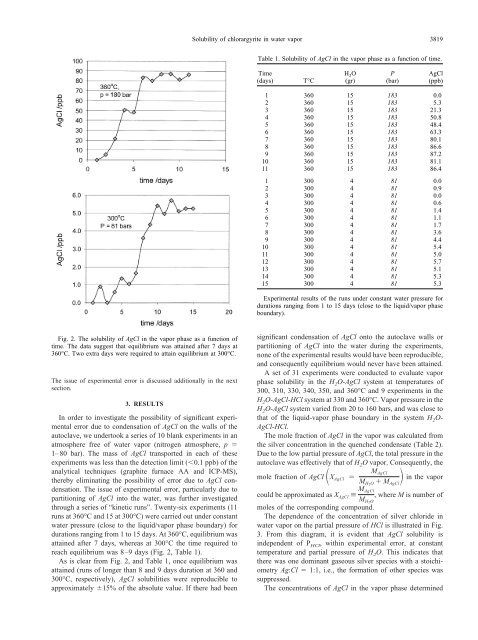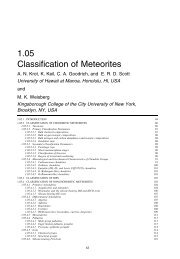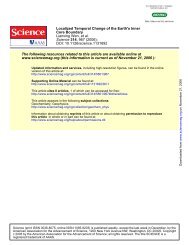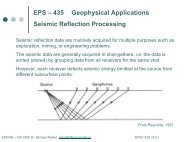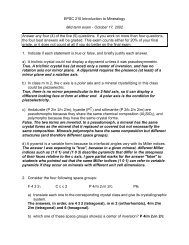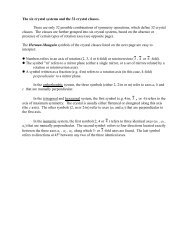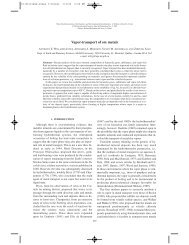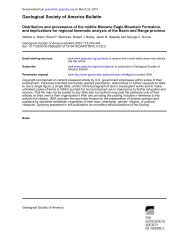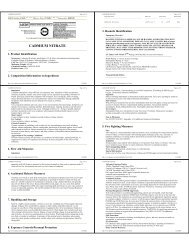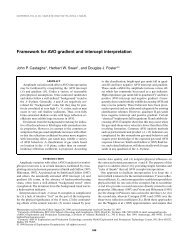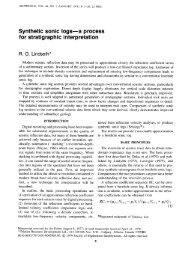Solubility of chlorargyrite (AgCl) in water vapor at elevated ...
Solubility of chlorargyrite (AgCl) in water vapor at elevated ...
Solubility of chlorargyrite (AgCl) in water vapor at elevated ...
You also want an ePaper? Increase the reach of your titles
YUMPU automatically turns print PDFs into web optimized ePapers that Google loves.
<strong>Solubility</strong> <strong>of</strong> <strong>chlorargyrite</strong> <strong>in</strong> <strong>w<strong>at</strong>er</strong> <strong>vapor</strong><br />
3819<br />
Table 1. <strong>Solubility</strong> <strong>of</strong> <strong>AgCl</strong> <strong>in</strong> the <strong>vapor</strong> phase as a function <strong>of</strong> time.<br />
Time<br />
(days)<br />
T°C<br />
H 2 O<br />
(gr)<br />
P<br />
(bar)<br />
<strong>AgCl</strong><br />
(ppb)<br />
1 360 15 183 0.0<br />
2 360 15 183 5.3<br />
3 360 15 183 21.3<br />
4 360 15 183 50.8<br />
5 360 15 183 48.4<br />
6 360 15 183 63.3<br />
7 360 15 183 80.1<br />
8 360 15 183 86.6<br />
9 360 15 183 87.2<br />
10 360 15 183 81.1<br />
11 360 15 183 86.4<br />
1 300 4 81 0.0<br />
2 300 4 81 0.9<br />
3 300 4 81 0.0<br />
4 300 4 81 0.6<br />
5 300 4 81 1.4<br />
6 300 4 81 1.1<br />
7 300 4 81 1.7<br />
8 300 4 81 3.6<br />
9 300 4 81 4.4<br />
10 300 4 81 5.4<br />
11 300 4 81 5.0<br />
12 300 4 81 5.7<br />
13 300 4 81 5.1<br />
14 300 4 81 5.3<br />
15 300 4 81 5.3<br />
Experimental results <strong>of</strong> the runs under constant <strong>w<strong>at</strong>er</strong> pressure for<br />
dur<strong>at</strong>ions rang<strong>in</strong>g from 1 to 15 days (close to the liquid/<strong>vapor</strong> phase<br />
boundary).<br />
Fig. 2. The solubility <strong>of</strong> <strong>AgCl</strong> <strong>in</strong> the <strong>vapor</strong> phase as a function <strong>of</strong><br />
time. The d<strong>at</strong>a suggest th<strong>at</strong> equilibrium was <strong>at</strong>ta<strong>in</strong>ed after 7 days <strong>at</strong><br />
360°C. Two extra days were required to <strong>at</strong>ta<strong>in</strong> equilibrium <strong>at</strong> 300°C.<br />
The issue <strong>of</strong> experimental error is discussed additionally <strong>in</strong> the next<br />
section.<br />
3. RESULTS<br />
In order to <strong>in</strong>vestig<strong>at</strong>e the possibility <strong>of</strong> significant experimental<br />
error due to condens<strong>at</strong>ion <strong>of</strong> <strong>AgCl</strong> on the walls <strong>of</strong> the<br />
autoclave, we undertook a series <strong>of</strong> 10 blank experiments <strong>in</strong> an<br />
<strong>at</strong>mosphere free <strong>of</strong> <strong>w<strong>at</strong>er</strong> <strong>vapor</strong> (nitrogen <strong>at</strong>mosphere, p <br />
1–80 bar). The mass <strong>of</strong> <strong>AgCl</strong> transported <strong>in</strong> each <strong>of</strong> these<br />
experiments was less than the detection limit (0.1 ppb) <strong>of</strong> the<br />
analytical techniques (graphite furnace AA and ICP-MS),<br />
thereby elim<strong>in</strong><strong>at</strong><strong>in</strong>g the possibility <strong>of</strong> error due to <strong>AgCl</strong> condens<strong>at</strong>ion.<br />
The issue <strong>of</strong> experimental error, particularly due to<br />
partition<strong>in</strong>g <strong>of</strong> <strong>AgCl</strong> <strong>in</strong>to the <strong>w<strong>at</strong>er</strong>, was further <strong>in</strong>vestig<strong>at</strong>ed<br />
through a series <strong>of</strong> “k<strong>in</strong>etic runs”. Twenty-six experiments (11<br />
runs <strong>at</strong> 360°C and 15 <strong>at</strong> 300°C) were carried out under constant<br />
<strong>w<strong>at</strong>er</strong> pressure (close to the liquid/<strong>vapor</strong> phase boundary) for<br />
dur<strong>at</strong>ions rang<strong>in</strong>g from 1 to 15 days. At 360°C, equilibrium was<br />
<strong>at</strong>ta<strong>in</strong>ed after 7 days, whereas <strong>at</strong> 300°C the time required to<br />
reach equilibrium was 8–9 days (Fig. 2, Table 1).<br />
As is clear from Fig. 2, and Table 1, once equilibrium was<br />
<strong>at</strong>ta<strong>in</strong>ed (runs <strong>of</strong> longer than 8 and 9 days dur<strong>at</strong>ion <strong>at</strong> 360 and<br />
300°C, respectively), <strong>AgCl</strong> solubilities were reproducible to<br />
approxim<strong>at</strong>ely 15% <strong>of</strong> the absolute value. If there had been<br />
significant condens<strong>at</strong>ion <strong>of</strong> <strong>AgCl</strong> onto the autoclave walls or<br />
partition<strong>in</strong>g <strong>of</strong> <strong>AgCl</strong> <strong>in</strong>to the <strong>w<strong>at</strong>er</strong> dur<strong>in</strong>g the experiments,<br />
none <strong>of</strong> the experimental results would have been reproducible,<br />
and consequently equilibrium would never have been <strong>at</strong>ta<strong>in</strong>ed.<br />
A set <strong>of</strong> 31 experiments were conducted to evalu<strong>at</strong>e <strong>vapor</strong><br />
phase solubility <strong>in</strong> the H 2 O-<strong>AgCl</strong> system <strong>at</strong> temper<strong>at</strong>ures <strong>of</strong><br />
300, 310, 330, 340, 350, and 360°C and 9 experiments <strong>in</strong> the<br />
H 2 O-<strong>AgCl</strong>-HCl system <strong>at</strong> 330 and 360°C. Vapor pressure <strong>in</strong> the<br />
H 2 O-<strong>AgCl</strong> system varied from 20 to 160 bars, and was close to<br />
th<strong>at</strong> <strong>of</strong> the liquid-<strong>vapor</strong> phase boundary <strong>in</strong> the system H 2 O-<br />
<strong>AgCl</strong>-HCl.<br />
The mole fraction <strong>of</strong> <strong>AgCl</strong> <strong>in</strong> the <strong>vapor</strong> was calcul<strong>at</strong>ed from<br />
the silver concentr<strong>at</strong>ion <strong>in</strong> the quenched condens<strong>at</strong>e (Table 2).<br />
Due to the low partial pressure <strong>of</strong> <strong>AgCl</strong>, the total pressure <strong>in</strong> the<br />
autoclave was effectively th<strong>at</strong> <strong>of</strong> H 2 O <strong>vapor</strong>. Consequently, the<br />
M <strong>AgCl</strong><br />
mole fraction <strong>of</strong> <strong>AgCl</strong>X <strong>AgCl</strong> <br />
M H2O M <strong>AgCl</strong> <strong>in</strong> the <strong>vapor</strong><br />
could be approxim<strong>at</strong>ed as X <strong>AgCl</strong> M <strong>AgCl</strong><br />
, where M is number <strong>of</strong><br />
M H2O<br />
moles <strong>of</strong> the correspond<strong>in</strong>g compound.<br />
The dependence <strong>of</strong> the concentr<strong>at</strong>ion <strong>of</strong> silver chloride <strong>in</strong><br />
<strong>w<strong>at</strong>er</strong> <strong>vapor</strong> on the partial pressure <strong>of</strong> HCl is illustr<strong>at</strong>ed <strong>in</strong> Fig.<br />
3. From this diagram, it is evident th<strong>at</strong> <strong>AgCl</strong> solubility is<br />
<strong>in</strong>dependent <strong>of</strong> P HCl , with<strong>in</strong> experimental error, <strong>at</strong> constant<br />
temper<strong>at</strong>ure and partial pressure <strong>of</strong> H 2 O. This <strong>in</strong>dic<strong>at</strong>es th<strong>at</strong><br />
there was one dom<strong>in</strong>ant gaseous silver species with a stoichiometry<br />
Ag:Cl 1:1, i.e., the form<strong>at</strong>ion <strong>of</strong> other species was<br />
suppressed.<br />
The concentr<strong>at</strong>ions <strong>of</strong> <strong>AgCl</strong> <strong>in</strong> the <strong>vapor</strong> phase determ<strong>in</strong>ed


